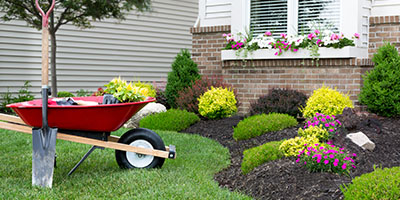The Complete Guide to Breaking Up and Removing Concrete by Yourself

How to Break Up Concrete: A DIY Guide
Front walkway starting to crumble? Looking to remove that concrete patio in your backyard? If the concrete is covered in deep cracks, shows signs of settling or is flaking away in large pieces, it’s probably time to get rid of it.
Demolishing a concrete slab can be a daunting and expensive task, but depending on the size and thickness of your slab, you might be able to tackle the project on your own. It’s important to note that you’ll get an intense workout in the process, so gather your friends to provide physical and moral support.
How Much Does Concrete Slab Removal Cost?
Removing a concrete slab yourself is an affordable alternative to hiring a professional:
- Contractors charge anywhere from $500 to $5,000 for concrete removal, with the average national cost being around $1,400.
- Typically, you can expect to pay about $2 to $4 per square foot of unreinforced concrete.
- Costs increase to $4 to $6 for reinforced concrete slabs.
Alternatively, the cost of a 12 lb. sledgehammer is usually less than $100 at big box retailers. Add in some teamwork and elbow grease, and you’ve just saved yourself potentially thousands in removing concrete.
What to Do Before You Demolish a Concrete Slab
Call 811
811 is the national call-before-you-dig phone number. Call to see if there are utilities located underground before you begin removing your concrete slab. When you call, you’ll need to provide:
- Your county
- The nearest cross street to your project location
- The type of project you’re working on
- The exact location of the concrete on your property
It’s important to have all your utilities marked before removing concrete so you don’t accidentally dig into a utility line.
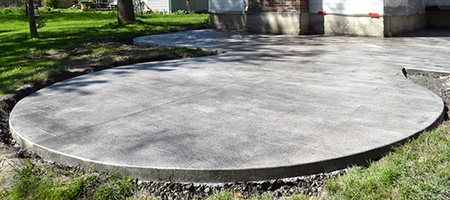
Check for Necessary Permits
Check with your municipality to see if a permit is needed to remove your concrete slab. If your driveway or sidewalk is in your town right-of-way, you’ll most likely need a permit before you begin your project. It’s less likely you’ll need a permit to demolish concrete in your backyard, but it’s best to check so you don’t end up paying any fines.
Measure Your Concrete Thickness
If your concrete slab is 4 inches thick or less, you can remove it with this guide. Anything more than 4 inches will require power tools and some experience.
Look for Concrete Reinforcement
Reinforced concrete is a slab of concrete with steel reinforcement bars, also known as rebar, or wire mesh inside. The steel or mesh strengthens the concrete and prevents it from bending and cracking. A driveway is likely made with reinforced concrete, while a concrete patio is likely made with unreinforced concrete.
While bolt cutters can handle some types of reinforcement, anything thicker than wire mesh will require an electric saw. You can find out what is in your concrete by breaking off an edge piece or expanding an existing crack. If your concrete contains rebar, consider hiring a professional.

"Make sure you know what type of concrete it is. While a 1 1/2-inch unreinforced slab is fairly easy – if time consuming – to remove DIY, a 6-inch thick reinforced concrete slab is different, and requires special tools and knowledge."
Yuko Kato, Fixr
Ask For Help
Removing concrete is hard work. Call up some friends to help you in your demolition project. Be sure to give them a heads up that they’ll be demolishing a concrete slab, so they’re prepared to get a serious workout in. And make sure everyone has plenty of water to stay hydrated.
By following our concrete demolition tips below, you and your team will learn how to break up concrete yourself, whether you’re replacing your sidewalk or removing your driveway.
Get a Dumpster On Site for Easy Debris Removal
Concrete Demolition Methods
There’s more than one way to break up concrete, but not every method is necessarily DIY-friendly. Here are the most common ways to remove concrete:
- Best for beginners: Sledgehammer and pry bar
- Best if you have advanced DIY skills: Jackhammer
- Best for no DIY experience: Hire a professional
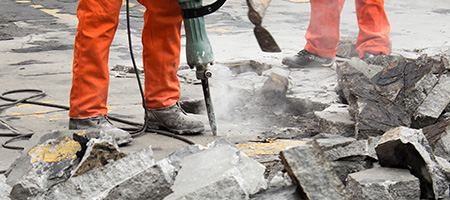
To use a jackhammer, you’ll need prior training as it’s a heavy, powerful tool — and it’s more expensive than a sledgehammer. This DIY guide focuses on using a sledgehammer to remove concrete, as it is the easiest and most affordable method to do it yourself.
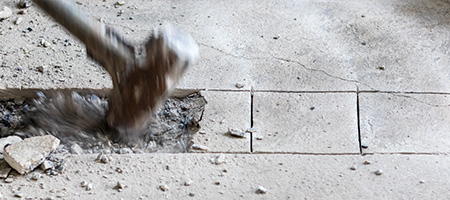
How to Break Up Concrete Without a Jackhammer
This concrete demolition method is best if your slab is relatively small and less than 4 inches thick. If you’re attempting a larger project, you’ll want to consider a different method, such as a jackhammer.
1. Gather Your Concrete Breaking Tools, Materials and Safety Gear
Demolishing a concrete slab can be dangerous. Make sure you have the correct tools for the job. Safety gear is especially important to protect your body from potential flying concrete and to keep your lungs from breathing in hazardous dust.

Tools
- Shovel
- 12 to 20-pound sledgehammer
- Pry bar
- Bolt cutters
- Mattock
- Wheebarrow or hand truck
Safety Gear
- Plastic sheeting or a drop cloth
- Safety glasses
- Gloves
- Steel-toed boots
- Hearing protection
- Dust mask
- Hard hat
- Long sleeves
- Pants
2. Prepare Your Work Area
Before you begin breaking up the concrete slab, cover any siding or windows near your workspace with plywood or plastic. This will protect them from any flying concrete. Then, cover your entire concrete slab with plastic sheeting to keep broken pieces from flying into the air.
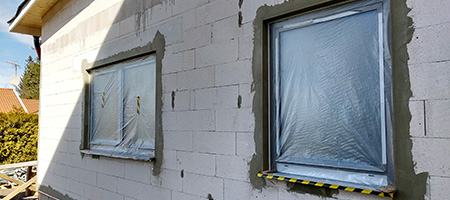
3. Create a Void Under the Concrete
If you attack the concrete right away, the dirt and sand under the slab will absorb your sledgehammer blows, making it harder to break it up. Creating a void under your slab makes the process easier. There are two ways to do this:
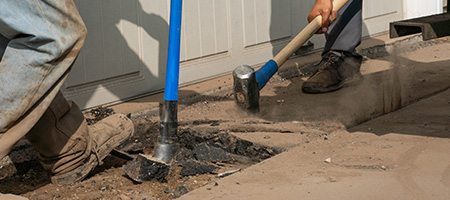
Undermine the Concrete
“Undermine” the concrete by digging out some of the dirt to create a void. To get started, use the shovel to dig 4 to 6 inches back from the edge of the slab and about 2 inches deep. This will give you the space you need to get under the concrete slab and start digging out some of the dirt. With that void started, you can use your sledgehammer to break up the concrete more easily.
Use a Pry Bar to Create a Void
Instead of digging under the concrete slab, you can also create a void using your pry bar. Once you’ve created some cracks with your sledgehammer, you can use the pry bar to lift smaller sections of the slab. The angle of the lifted section creates a void without you having to dig.
To use the pry bar, stick the end of the pry bar under a portion of the slab. Then, have one person use the pry bar as a lever to lift the chunk slightly while the other person uses the sledgehammer. Use a cinder block or rock as a fulcrum to create more leverage if necessary.
4. Break Up Concrete With a Sledgehammer
Now it’s time to demolish the concrete slab. When you’re ready, aim your first hammer blows within 6 inches of an edge:
- Lift the hammer with one hand close to its head and the other close to the base.
- Raise the hammer as high as possible, but not over your head.
- Aim your sledgehammer and let it fall while sliding your top hand to the base of the hammer to meet your other hand.
Don’t swing your sledgehammer, which may cause injury. Let the hammer and gravity do all the work for you.
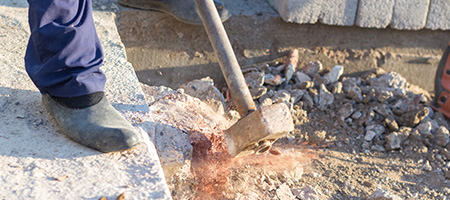

Concrete Demolition Tip
If the slab doesn’t immediately crack, don’t hit the same spot a second time. Move a few inches in any direction and hit again.
Work your way across the slab in a grid pattern, taking breaks after each section you hammer. Avoid placing hammer strikes too close together. When removing concrete, you want the pieces to be small enough to lift, but you don’t want to create gravel, which is hard to move with your hands.

"Make use of the existing cracks. You can use them as entry points to begin lifting larger pieces up and carting them away."
Yuko Kato, Fixr
5. Remove Your Concrete Slab as You Go
Now that you’ve made serious cracks with your sledgehammer, it’s time to break up the concrete slab. Insert the pick of your mattock into the cracks to separate the concrete into pieces and get them out of the way. Use bolt cutters to cut any wire mesh in the concrete. Lifting with your legs, load debris into your wheelbarrow or stack it on your hand truck, but do not overload it.
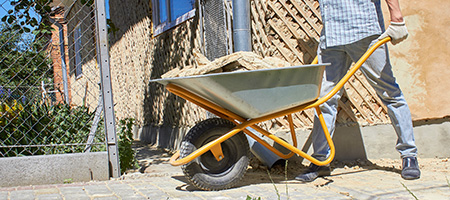

Concrete Demolition Tip
Concrete is difficult to haul, and might not be accepted in your weekly trash pickup. Clean as you go — rent a dumpster to have on-site for easy removal.
6. Repeat Steps Until the Concrete Is Fully Demolished
As you get to the middle of the concrete slab, continue to dig under the edges or use the pry bar to create a void and break apart the concrete using the sledgehammer. Repeat these steps until all the concrete is loose and movable.


Concrete Demolition Tip
Removing concrete is a tough job and takes a toll on your body. Take frequent breaks as you move through your slab.
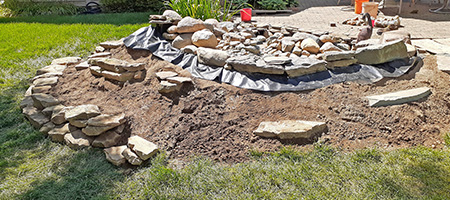
What to Do With Your Leftover Concrete
If you don’t have a dumpster rental on-site, there are plenty of other ways to get rid of your concrete:
- Take on your next DIY project by reusing your concrete pieces to create a mosaic walkway or build a fire pit in your yard.
- Give it away to friends and neighbors who could use it in their landscaping projects.
- Bring your demolished slab to your nearest landfill yourself. However, this option requires some more elbow grease, and you may end up taking multiple trips to the landfill.
If you're concerned about where your trash goes after you throw it away, don't despair. A little research goes a long way in helping you decide what to do with all of that leftover concrete.
Need more ideas on what to do with your leftover concrete?
Learn How to Dispose of Concrete and Asphalt!

